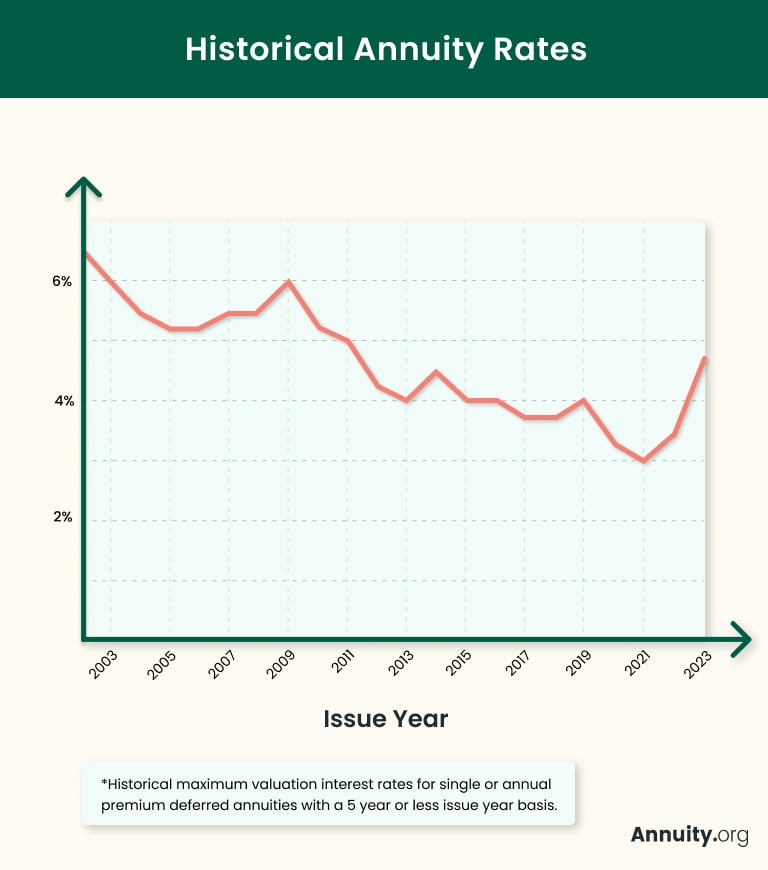Annuity Rates for January 2024
An annuity rate is the percentage by which an annuity grows each year. Annuity rates are determined by insurance companies. The annuity return rate depends on how much money is invested, how the interest is credited and the length of the contract.
Key Takeaways
- Insurance companies set annuity rates and may determine a guaranteed rate for a set period.
- Fixed annuities earn interest at a predictable rate, while the rates of indexed annuities and variable annuities fluctuate based on market conditions.
- Interest rate environments, stock market investments and index performance influence annuity rates.
Today’s Best Guaranteed Annuity Rates by Term
- 1-Year: 5.25%
- 2-Year: 5.65%
- 3-Year: 5.9%
- 4-Year: 5.85%
- 5-Year: 6.05%
- 6-Year: 5.95%
- 7-Year: 5.95%
- 8-Year: 5.7%
- 9-Year: 4.85%
- 10-Year: 6%
Consumers should determine how much they would like to invest in an annuity, then shop around to various highly rated insurance companies (look for at least an A- rating) to see what their rates are, and do comparison shopping, like you would when you buy a car.
Best Fixed Annuity Rates This Week
Multi-year guaranteed annuities, or MYGAs, are a type of fixed annuity that guarantees a fixed interest rate for a specified time period — usually three to 10 years. Like traditional fixed annuities, MYGAs are subject to fees called surrender charges, which an annuity holder must pay if he or she withdraws money from an annuity before the specified time period is over.
Because MYGA rates change daily, Annuity.org and its partners update the following tables frequently. Therefore, it’s important to check back for the most recent information.
| Product | Rate | Guarantee Period | Surrender Period | AM Best Rating |
|---|---|---|---|---|

Certainty Select |
6.00% | 10 Years | 10 Years | B++ |

Platinum Assure |
5.95% | 5 Years | 5 Years | A |

Platinum Assure |
5.95% | 5 Years | 5 Years | A |

Platinum Assure |
5.95% | 6 Years | 6 Years | A |

Platinum Assure |
5.95% | 7 Years | 7 Years | A |

Aspida Advisory MYGA |
5.90% | 5 Years | 5 Years | A- |

Platinum Assure |
5.85% | 4 Years | 4 Years | A |

Platinum Assure |
5.85% | 4 Years | 4 Years | A |

Safeguard Plus |
5.80% | 5 Years | 5 Years | B++ |

Aspida Advisory MYGA |
5.80% | 7 Years | 7 Years | A- |

Aspida Advisory MYGA |
5.75% | 3 Years | 3 Years | A- |

MYGA |
5.75% | 3 Years | 3 Years | B++ |

CL Sundance 2-Year |
5.70% | 3 Years | 3 Years | B++ |

MYGA |
5.70% | 4 Years | 4 Years | B++ |

MYGA |
5.70% | 5 Years | 5 Years | B++ |

MYAnnuity 5X – No Free Withdrawal |
5.70% | 7 Years | 7 Years | B++ |

Certainty Select |
5.70% | 8 Years | 8 Years | B++ |

Safeguard Plus |
5.65% | 3 Years | 3 Years | B++ |

WealthLock MYGA Plus |
5.65% | 5 Years | 5 Years | A- |
 Certainty Select |
5.65% | 6 Years | 6 Years | B++ |
Fixed annuities provide a guaranteed rate, similar to a bond or CD. They are most appropriate for the portion of your savings that you want to provide a stable rate of return without volatility.
How Annuity Rates Work
Annuities are insurance products that exchange an upfront premium for a stream of income payments beginning at a later date. Deferred annuities undergo an accumulation phase during which the contract’s value may increase before being converted to income payments.
The percentage by which the annuity grows over time is called the annuity’s rate. As Jason Ball, a Certified Financial PlannerTM professional, told Annuity.org, “This rate determines the size of the regular payments that the annuity holder will receive once the annuity starts paying out.”
“Annuity rates can either be fixed, meaning the rate stays the same over the life of the annuity, or variable, which means they can fluctuate based on the performance of underlying investments,” said Ball.
The guaranteed interest rates for traditional deferred fixed annuities and MYGAs make these two types of annuities easy to understand when it comes to interest rates and the return these products can provide over the course of the contract term.
Variable, income and fixed index annuities are more complicated. Because their returns are not calculated according to a guaranteed stated interest rate for a set period, consumers will not find rates for these products when searching for the best annuity rates.
How Do You Compare Rates for Different Types of Annuities?
Annuity rates are tricky to compare because, as previously mentioned, different types of annuities earn interest in different ways. For example, traditional fixed annuities guarantee an interest rate for a one-year term, whereas other fixed annuities guarantee rates for anywhere from three to 10 years. These multi-year term contracts are called multi-year guaranteed annuities (MYGAs).
Conversely, variable annuities don’t guarantee interest rates because their earnings depend upon the performance of an underlying stock portfolio.
And yet another type of annuity, the fixed index annuity, employs unique crediting methods based on the performance of a stock market index.
This can be perplexing to the average consumer.
It helps to understand that annuities fall into three specific buckets:
How Do Annuity Rates, Pricing Levers and Growth Potential Interact?
In addition, many annuities have pricing levers — interest rate floors, caps and participation rates — that affect their growth potential.
The interest rates for indexed and variable annuities fluctuate with the stock market. Therefore, people who purchase one of these annuity types must review either the variable annuity prospectus or the strategy options and rate sheet for the specific indexed product they are buying.
Income annuities (FIAs and DIAs) are typically quoted using either the monthly income payment amount or an annual payout rate that represents the percentage of the premium amount that the annuitant has received in income payments.
This leaves deferred fixed annuities and MYGAs, which — as we’ve established — are the least complex products. Their guaranteed interest rates make them easy to understand when it comes to interest rates and the return they can provide over the course of the contract term.
Fixed annuity rate quotes are useful when choosing among annuities offered by different carriers.

What to Consider When Comparing Annuity Rates and Withdrawal Provisions
Many carriers offer penalty-free withdrawal provisions that allow the annuity holder to make partial withdrawals before the surrender period ends without incurring fees. For example, some contracts allow annuity holders to withdraw up to 10%, starting in the first year.
“Consumers should determine how much they would like to invest in an annuity, then shop around to various highly rated insurance companies (look for at least an A- rating) to see what their rates are, and do comparison shopping, like you would when you buy a car,” Certified Financial Planner™ professional Rubina Hossain told Annuity.org.
Contracts with less generous withdrawal provisions may have higher rates. If you want the possibility of higher rates than fixed annuities offer and are willing to take on more risk, you can explore fixed index or variable annuities.
How soon are you retiring?
What Factors Influence Annuity Rates?
The rates of fixed annuities are influenced primarily by interest rates in other parts of the financial system. This is because of the way insurers invest in annuity premiums to generate returns.
Insurers’ fixed annuity portfolios are composed of relatively safe investments like bonds. So when interest rates on bonds and similar products rise — as they have throughout 2022 and much of 2023 — the higher yields insurers receive from their portfolios are passed to consumers as more generous fixed annuity rates.
“If interest rates go up, it’s expected annuities will pay out more,” Branislav Nikolic, the Vice President of Research at CANNEX, told CNBC.
Different economic conditions affect the rates of indexed and variable annuities. Because the rates of these annuities are directly tied to an index or investment portfolio’s performance, the overall health of the stock market and its indexes can impact how much a variable or indexed annuity earns.
In addition to index performance, fixed-indexed annuities employ a number of pricing levers to affect how interest is credited to the contract. These levers are designed to both minimize downside risk and somewhat limit exponential growth in the event that the controlling index performs exceptionally well.
Indexed Annuity Pricing Levers
Read More: The Cost of Waiting for Interest Rates to Rise
Will You Be Able To Maintain Your Retirement Lifestyle?
Learn how annuities can:
- Help protect your savings from market volatility
- Guarantee income for life
- Safeguard your family
- Help you plan for long-term care
Speak with a licensed agent about top providers and how much you need to invest.
Frequently Asked Questions About Annuity Rates
Annuity rates are set by the insurance company that issues the contract.
Fixed annuities have guaranteed interest rates for a predictable income stream. These rates are set by the annuity company and detailed in your contract when you purchase. Variable annuities have interest rates based on the performance of an investment portfolio.
When interest rates are high, fixed annuities are likely to have higher rates, so it’s a good time to lock in that rate by purchasing an annuity.
Unless your annuity has a bailout provision, you likely won’t be able to cancel your annuity contract without a hefty surrender charge, even if the rate on your annuity declines.

